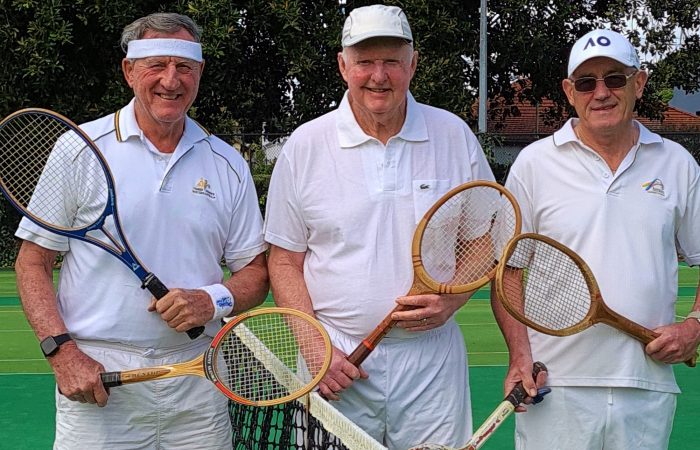
Confirming that tennis, mateship and longevity go hand in hand, a group of devoted tennis enthusiasts are celebrating more than 40 years of playing together as part of the longstanding Midweek Winter Men’s competition.
Forefathers of the group Henry Michael, Gordon Gregory , Phillip Massey and Richard Horsley (Dec) first played at the Canning Tennis Club in May 1980 in a bid to maintain their competitive streak during the winter months. Word travelled quickly of the out-of-season playing opportunity, with numbers growing rapidly to as many as 20 social players each week.
With tennis enthusiast uniting from clubs across the metropolitan area, and as far away as York, the group which has spent time playing at North Perth and the State Tennis Centre, has called Roberston Park Tennis Centre (North Perth) home for the past 10 years.
Proving that tennis is more than just a sport, the group which has met weekly for the past 40 years between May and October when the traditional summer playing season takes leave, have shared and seen it all. Beholding the remarkable shift from wooden racquets and tennis whites, the group have supported each other through the good times and the bad with tennis as the constant for more than four decades.
Original member and current timekeeper Henry Michael says the group first came to be in a bid to continue playing throughout the winter months where the focus has always remained on high level, top quality playing opportunities for everyone.
‘The original members which include myself, Gordon Gregory, Phillip Massey and the late Richard Horsley wanted the opportunity to play high level tennis throughout the winter months and so we came together for a hit,’
‘We each played at different clubs across Perth during the summer pennants and were united by the fact that we wanted to keep playing high level tennis throughout the winter, and that fact hasn’t changed,’
‘The key to the group continuing has been driven by the fact that we all just want to keep playing at the top of our game,’
‘Forty years later and the focus of the group remains on playing high level competitive tennis and for everyone on court to have a good tough match,’ Michael said.
United through a love and passion for good quality tennis and bonded through the comradery of coming together for so many years, fellow original member Gordon Gregory says that tennis aside, mateship is a big part of what has kept the group together.
‘Tennis brings us together but the really great feeling of having good friends from different clubs who you can have a meal or a drink with after the game is something else,’
‘We play social tennis at a very competitive level where we all still like to win but there are no ill feelings because of the good sportsmanship that surrounds the group,’
‘I keep playing because I enjoy it and part of that is the friendship, and that’s the secret – enjoying yourself and appreciating each other’s company,’ Gregory said.
And taking the enjoyment of tennis and the value of friendship to the next level, York farmer Justus Van Der Westhuizen is as committed as they come, travelling up to two hours each way every week just so he can play good tennis with his good friends – and it’s something he’s been doing for twenty years.
‘I’ve played tennis all of my life, I grew up in South Africa hitting a ball against a wall and before I knew it I’d progressed to playing seniors tennis,’
‘When we moved to Australia in 2000 I joined the York Tennis Club and Tennis Seniors before being invited to join the Midweek Winter Men’s competition,’
‘I’ve been travelling from York to play with the group for the past twenty years and I’ve made a lot of good friends along the way,’
‘There’s players of all different ages and were all really good friends. We enjoy each other company and the fact that we get to play more tennis is a bonus,’ Van Der Westhuizen said.
And according to a study published in September 2018 by Mayo Clinic proceedings, the longstanding group of midweek players are winning both on and off the court. The study, which followed 8577 participants over 25 years, found that the life expectancy of tennis players was increased by 9.7 years, significantly outperforming activities such as running, cycling, swimming, soccer and health club activities.
The observational study, which began in 1991, analysed the distribution and determinants of health and disease across defined population groups, concluding that sports with increased social interaction, proved to correlate positively with increased longevity. Not surprising then, that tennis aced the study as a standout.
The Copenhagen study isn’t alone in its findings either, with supportive evidence proving that good interpersonal connections brings twice as much protection against early mortality. Above all, what proves most important, is regular participation in interactive sports that provide both exercise and social connectedness. Belonging to a group or team that meets regularly, is repeatedly proven to contribute positively to a sense of well-being with significant impacts long-term health.
Find out more about the study by heading to https://www.mayoclinicproceedings.org/

